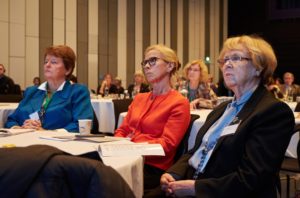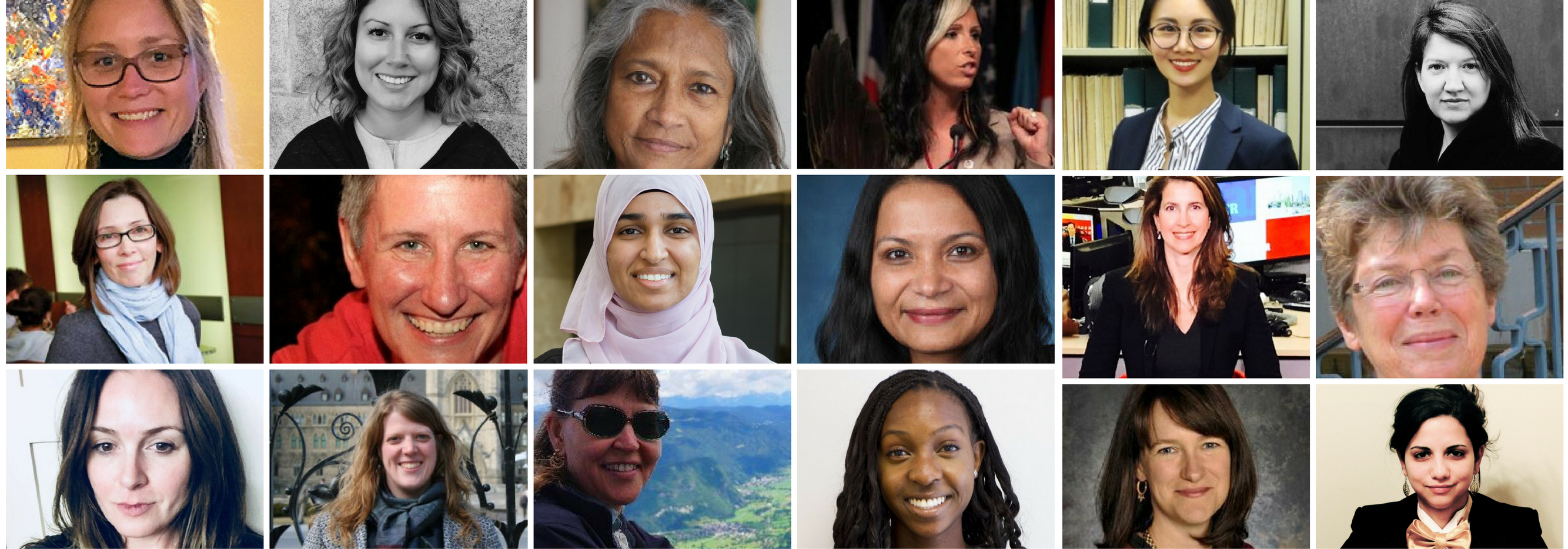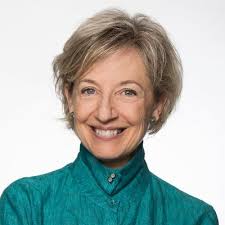
The genie is now out of the bottle, the bottle itself is broken, and the forces unleashed by the extraordinary events of the past 18 months will not be constrained. That’s the image I have of the irreversible momentum of women speaking up and insisting on being heard regarding the realities of their lives.
But the fact that it took the election of a US president referred to as the “Groper in Chief” to trigger this moment remains as infuriating as his persistent lies, toxic racism and defence of guns. Because, as invigorating as it is to see the unprecedented attention now being paid to the consequences that flow from the silencing of women, the absence of women’s experience-informed perspectives was fully evident before the waves of revelations about how often women’s careers are derailed by sexual harassment or assault.
In 2010, Informed Opinions, the nonprofit initiative I run, conducted content analysis research documenting the ratio of male to female voices in some of Canada’s most influential media. On newspaper opinion pages and prominent broadcast news shows, men’s views outnumbered women’s by four or five to one. This underrepresentation is central to the invisibility of issues that affect women more, or differently, than men.
What other stories are buried beneath unconscious bias or accepted sexism? And what will it take to find out? I think the prescription is surprisingly simple and was already being implemented by a few journalists in advance of this remarkable cultural moment. In short, journalists need to proactively seek out, quote and feature as many female sources as male sources.
The Atlantic science reporter Ed Yong has been tracking the male-to-female ratio of experts and sources he consults for his stories for the past two years. He calls the spreadsheet of his results “a vaccine against self-delusion.”
Yong considers himself an ally who cares about women’s equality, but when he started monitoring how well he was doing at incorporating the views of female sources, he discovered that his “passive concern” was meaningless. His simple tally revealed that more of his default sources were male. In response, he has actively sought out expert women to interview. That he’s been able to achieve parity over the past two years, while covering fields that remain overwhelmingly dominated by men, is a tribute to his reporting skills.

But his success also demonstrates that women with informed opinions are both available and willing to provide analysis that adds value to public conversations. Having personally interacted with thousands of Canadian women who boast expertise on everything from flood plains and vaccinations to big data and neuroscience, I already knew that. Informed Opinions hosts a database featuring hundreds of qualified-to-comment expert sources. But many people persist in believing that qualified women are really difficult to find, and that for many, if not most, stories, a “best” person exists. Yong challenges both these and other predictable but myth-based criticisms.
His initiative echoes efforts made by Canada’s public broadcasters, which have been tracking their gender ratios for some time. In December 2016, Matthieu Dugal, the host of the French-language radio show La Sphère, shared on social media that his program had achieved gender parity — even though its focus is technology.
Content analysis research we commissioned in 2015 offers an even broader sample. The independent scholar Marika Morris reviewed the gender of sources quoted by seven of Canada’s most influential news media outlets over three weeks in the fall of 2015. Although male experts still outnumbered females by more than two to one in aggregate, Radio Canada, CBC and TVO all featured more than 40 percent women. In contrast, the private TV news show and the front sections of the three newspapers studied had between 23 and 34 percent female sources.
What explains the difference in the gender ratio of sources? It comes down to that old business maxim — and now the name of our newest initiative — What Gets Measured Gets Done. Like individual reporters, news organizations that track their sources do a better job of offering diverse perspectives, and public broadcasters view that as a measure of performance. Their private sector counterparts? Not so much.
But what if it were a requirement of the job for all news and information media to measure the diversity of their sources? And not just for gender, but for other forms of diversity too?
Canadians are proud to tout our democratic institutions, including our free and independent media, but how democratic is the journalism we rely on if it’s reflecting the perspectives of only a relatively narrow and unrepresentative subset of the population?
It’s true that parliamentary and business reporters have no control over the gender imbalance in the cohorts they cover; as long as legislatures, council chambers and corner offices are populated largely by men, the pronouncements of the men with power will continue to carry more weight. But, given that imbalance, people who aren’t equitably represented are likely to experience more negative effects and unanticipated consequences from the decisions made and actions taken. Shouldn’t the media work harder to reflect their views?
Doing so is also likely to make it easier for women to be seen as authoritative sources, capable of leading. Role models matter, and cultural change has been called the dress rehearsal for political change.
Vigdís Finnbogadóttir, who served Iceland as president for 16 years, understands well the power of role modelling. She recounts the story of a young boy in her country seeing Ronald Reagan on TV and asking in confusion, “Mommy, can a man be president?” Visible female leadership makes women’s capabilities not just conceivable but inevitable. Even the presence of strong female role models in fictional movies and TV shows has been credited with helping to shift voters’ perception of what qualities and characteristics constitute effective political leadership.

As importantly, the imbalance of voices in public discourse influences what gets prioritized, funded and covered. This has profound policy implications — and not just for so-called “women’s issues” like equal pay and child care. To be clear, the inequities in the former and the absence of choice in the latter affect all of us, economically and socially. But our research finds that women are more inclined to ask questions and pose solutions for a wide range of other topics that don’t make headlines when only men’s voices are present. These include heartbreakingly predictable issues such as sexual abuse of children and violence against women, but also broader concerns like access to water and food, dementia and safety.
Hundreds of the women we’ve motivated, trained and supported over the last eight years have subsequently published commentaries in influential print and online media. In sharing their experience-informed opinions on everything from prison reform and government budgeting to autism treatment and policing practice, they have shifted conversations, changed policies and reversed legislation.
A healthy democracy depends on the inclusion of more women’s perspectives, and Canada’s media policies have explicitly recognized this for decades. The Broadcasting Act designates the airwaves a public utility that exists for the benefit of all Canadians. And on paper, the Canadian Radio-television and Telecommunications Commission (CRTC) has made adhering to gender representation guidelines a condition of licence. Broadcasters are supposed to demonstrate how they’re meeting those guidelines when seeking their licence renewal every seven years. However, most broadcasters have largely ignored these equity goals, and the CRTC has failed to enforce the expectations.
But the research case making clear the benefits of including women’s voices is now unassailable, and our current federal government has made gender equity a priority, and not just in cabinet appointments and policy initiatives. Last year, Science Minister Kirsty Duncan, recognizing the demonstrable impact that unconscious bias continues to have on female scholars’ access to research dollars and promotion, announced that universities would have to meet diversity targets in order to secure Canada Research Chair funding.
Appreciating the value of such incentives, we’re now working with some data scientists to build a digital dashboard that will actively track the ratio of male to female sources quoted by Canada’s most influential news media. We will encourage both journalists and news consumers to access the publicly available data, and to pay more attention to the diversity of sources they quote. We’ll use the results to celebrate the leaders and motivate the laggards. Canada’s public discourse will be not only richer and more interesting but also more democratic when it features more gender-balanced perspectives.
For the past eight years, I’ve been reminding women that we have to “take the mic” and stop silencing ourselves in anticipation of being silenced by others. Now that we’re doing that, journalists need to do their part.
Photo: Some recent contributors to Policy Options and the IRPP. Photo collage by Ann-Catherine Désulmé.
Do you have something to say about the article you just read? Be part of the Policy Options discussion, and send in your own submission. Here is a link on how to do it. | Souhaitez-vous réagir à cet article ? Joignez-vous aux débats d’Options politiques et soumettez-nous votre texte en suivant ces directives.









